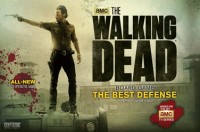
The Walking Dead Board Game: The Best Defense
Overview
The Walking Dead Board Game: The Best Defense takes 1-4 players into a rough world where the odds are not in their favor. Resources are precious and scarce, decisions can mean life or death for the survivors, and you must keep the walkers (zombies) at bay or you’ll quickly be overwhelmed.
This isn’t a game you’ve played before with The Walking Dead franchise layered on. Cryptozoic Entertainment has taken the gritty survival atmosphere of the TV series and created a completely fresh cooperative gameplay experience.
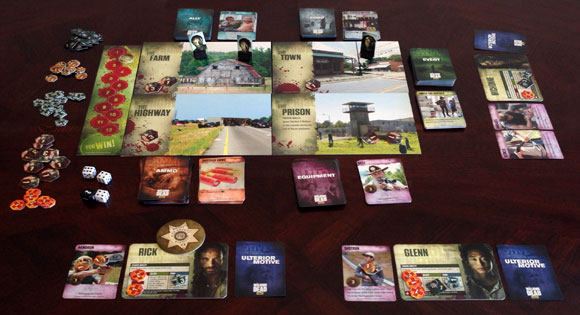
Set Up
Setting up a game of Best Defense is quick and easy.
Each player chooses one survivor (popular characters from the series) and starts with a set amount of health and resources
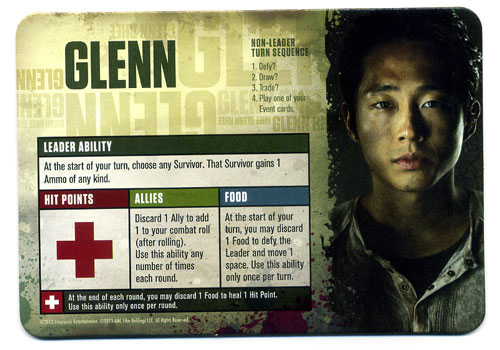
The four location tiles are randomly placed in a 2×2 grid and you randomly determine which of the four resource decks will go with each location. Each player will roll the black die (d6 with sides: 1,1,2,2,3,3) and put that many walker tokens onto the location closest to where they are seated.
Finally, players draw one equipment card (and hope it’s a good one!). If you’re lucky enough to draw a weapon, you get to take ammo as well (the card will say “start of game load”). All weapon cards drawn later in the game are unloaded.
Let the survival begin!
Gameplay
To win a game of Best Defense your group must survive for 12 rounds and make sure none of the four resources run out. Actually surviving 12 rounds is not an easy task. You will probably lose the game quite a bit (depending on the difficulty you choose), but that’s half the fun and the challenge. If you win, it will usually be by the skin of your teeth!
Protect your resources
The four resource decks in the game are Ally, Equipment, Ammo and Food. Players can draw from them, and walkers will attack unprotected decks (discarding one card for each walker attack). With only 25 cards in each resource deck, survivors will need to balance how badly they need a resource, as well as making sure they don’t leave resources unprotected.
Here’s the general look at what the resources do for the survivors:
- Ally: You’ll gain ally tokens which allow you to add to your combat points to your rolls.
- Equipment: These cards provide you with weapons, armor, faster travel and healing.
- Ammo: Need ammo for a weapon… this is where you’ll get it.
- Food: You gain food tokens which you can discard to heal your survivor or defy (move on your turn).
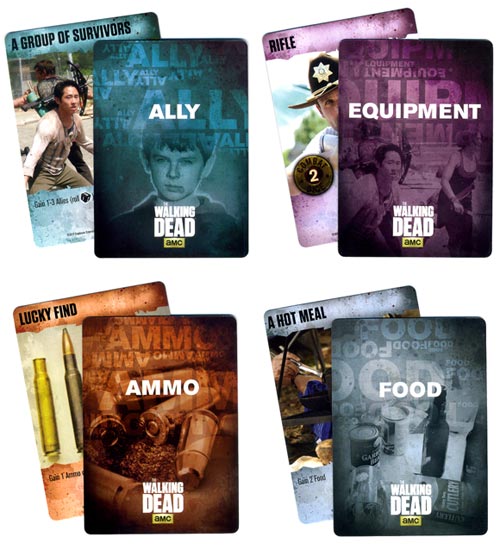
Choose your difficulty
Best defense has a a great range of difficulty “settings” that can be chosen based on the type of experience you want to have as well as the group you’re playing with. Before you start playing, you’ll choose one mode and one difficulty.
- Standard Mode: Players can choose a new survivor if theirs dies
- Hardcore Mode: The game ends if a survivor dies
- Beginner Difficulty: Event cards are visible to everyone
- Expert Difficulty: Event cards are kept hidden and strategic discussion is limited
Suggested difficulty combos:
- If you’re looking to introduce players to the game, combine Standard mode with Beginner Difficulty.
- If you’ve got someone who always tends to take control of cooperative games, choose the expert difficulty which will let each player make more of their own choices, while still playing as a team.
- If you’re wanting the biggest challenge, combine Hardcore mode with Expert Difficulty (We found we had the most fun playing this way).
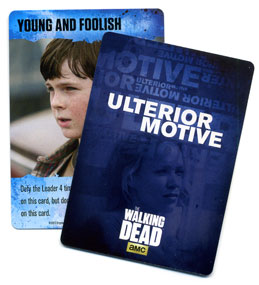
Ulterior Motives Variant
As an option, each player can receive a secret Ulterior Motive card. They aren’t shown to other players and typically involve collecting things or performing certain tasks to complete them. What’s fun is how they may cause players to make decisions that might not be in the best interests as everyone else. They also act as “mini achievements” that can make the game more fun for each player. We found these are the most fun while playing in Expert Difficulty. Also, you don’t need to complete them to win the game.
Take your turn
At the start of each round players will discuss their strategies and then each player is dealt two event cards. On Beginner difficulty players can continue to discuss their strategies. On Expert Difficulty strategic discussion is no longer allowed until the combat phase.
Event Cards
These cards rarely have good outcomes, and each round the leader will play both event cards, and the no-leaders will chose one of the two to play. The cards typically have two phrases: If your survivor is at ____ location do A (“A” usually involving drawing a resource card). If not, do B (“B” usually involving rolling the black die to add walkers to the board). The event cards that don’t have two phrases typically cause even worse things to happen. The event cards emphasize how the leader and non-leaders’ movement decisions will greatly impact the outcome.
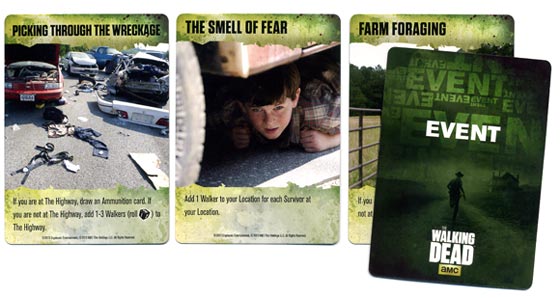
Leader’s Turn
After event cards have been dealt out the player turns begin, starting with the leader and moving around clockwise.
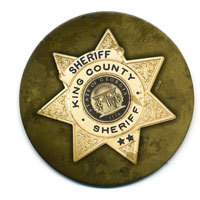
As the leader you get to move each player one space, or leave them where they are. This movement is based HIGHLY on what event cards you’ve been dealt as the leader, but also what event cards other players were dealt.
After moving the survivors the leader may draw a resource card from the location their survivor is on, trade (give and/or receive) one item with a survivor at their location and then must play both of their event cards (in the order they choose).
Non-Leader’s Turn
Going clockwise from the leader, non-leaders will take their turn.
Non-leaders can’t move unless they choose to “Defy the Leader.” To do this they discard one food token and can then move one space. This is useful if they don’t like where the leader moved them. Or, if they coordinated this with the leader, it could essentially allow them to move two spaces in one turn (note that you can’t move diagonally)
After choosing to stay or defy, the non-leader may draw a resource card from the location their survivor is on, trade one item with a survivor at their location and then must play one of their event cards (discarding the other).
Fight the walkers
Once each player has taken their turn it’s time for the survivors to take down as many walkers as they can. Survivors can only attack the walkers that are on their location, and must choose whether to combine their attacks (ranged weapons only) or take them separately. Rule of thumb: 2+ guns are always better than one!
Combat is simple. You choose a weapon (if it’s a ranged weapon you will need to discard one ammo token from it), roll the number of white die based on the number shown on the combat dice symbol, and the total makes up your Combat Points. For every 5 combat points, one walker is removed. If you decided to combine attacks, both players must attack, even if after one player’s roll all the walkers are gone.
End the round
If there are still walkers left after the combat phase, they each do one damage. If there are survivors on their location, the survivors must divvy up the damage. If there aren’t any survivors on their location (or there is damage left over after the survivor(s) have died) they damage the resource deck by discarding one card per damage. This means your group can’t just hang out on a couple locations and let the others get overwhelmed by walkers because they’ll quickly deplete the resources causing you to lose the game. (ie: 8 walkers on a location would deplete a full resource deck in just three rounds!)
If all your survivors are still alive and no resource piles have been depleted, your group has survived the round! Move the round marker up, move the leadership token to the next player (clockwise) and keep surviving until you’ve made it to the winning space.
Components
Cryptozoic has really done a great job with the entire package. The box insert is textured with black felt and includes spots for all the components. The character cards are actually thick boards which is a nice edition. The graphic design and photography used does a great job of pulling you into the world of The Walking Dead. If you’re a fan of the TV series you’ll “eat this game up!” (sorry, had too)

Learning Curve
Best Defense is very easy to learn and teach to others. There are even rules for solo mode which is a great way to take the game for a spin before teaching others how to play.
Who would enjoy this game?
Final Thoughts
The Walking Dead Board Game: The Best Defense does an awesome job of letting players experience the “reality” of surviving as a team during a zombie apocalypse. Things don’t gradually get better, they get worse! In many zombie games players will gain resources and other items that make it much easier to overcome whatever challenges come next. The things you gain in Best Defense will only give you a little bit of an edge, and finding an awesome weapon will do you no good unless you’ve also got matching ammo on hand.
This isn’t a game like Pandemic or Flash Point: Fire Rescue where you save the day and live happily ever after. In Best Defense, IF you win, your survivors will probably be battered and bruised, some barely alive… your resources will be almost completely depleted, and the board will probably still have walkers all over it. The experience of winning could be compared to making your way through a zombie ridden building looking for resources, and barely making it out, closing the door behind you with a building still full of zombies (and maybe a survivor or two who didn’t make it out). Now don’t let this discourage you though. It’s the challenge of working together as a team to beat overwhelming odds that makes the game so fun.
The ulterior motive cards, though optional, add nicely to the theme. Yes, you’re a team working together… but you’re also a group of individuals from all walks of life, each with your own responsibilities for survival.
Like most licensed games, there is an extra level of immersion you’ll enjoy if you are a fan of the TV series. At the same time, you’ll still have just as much fun if you’ve never heard of The Walking Dead.
If you enjoy cooperative games, The Walking Dead Board Game: The Best Defense offers a fresh experience worthy of your board game collection. It’s a game that will challenge you each round, and a fun test of team survival… even if you don’t survive!
User Reviews (2)
Add a Review for "The Walking Dead Board Game: The Best Defense"
You must be logged in to add a review.

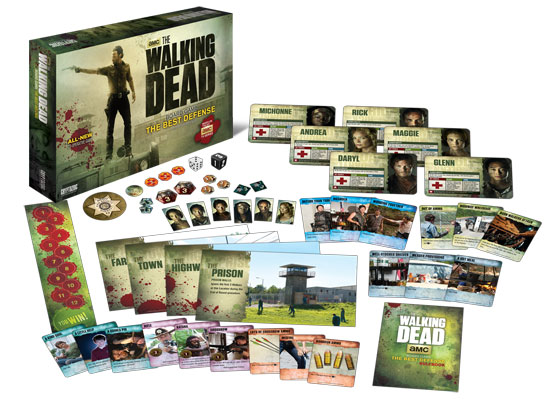
Overview
The Walking Dead: Best Defense is a Co-Op game for up to 4 players taking anywhere up to an hour to play. As the title of the game says, its based off The Walking Dead televisions series as it uses images from that.
In an age with a lot of quality co-op games and zombie games lets see how this looks.
Gameplay
There are two difficulty settings to this game. Beginner and Hardcore.
Beginner allows you to always talk to each other, and if a survivor dies, you just grab an unused one and keep on chugging away.
Hardcore If a survivor dies the game ends. There is not talking except during combat.
The game can be lost once the last card of a pile is removed due to drawing or zombies.
Combat is simply rolling dice and killing one zombie for every five points of damage you do.
The gameplay is repetitive, not in the good way, but in the boring way. The weapons suffer from huge disparity in their effectiveness. The katana pretty much guarantees you the game as if you roll a 4+ you keep on rolling and adding it up. This allows you to pretty much dominate. Beginner or Easy mode is pretty much a guaranteed win normally.
Components
Most of the components just felt really cheap. The Box is way too big for what it contains. The only reasons its that big is to say “Hey Walking Dead Game Here!”, also for the cover art on it. Have to say its a pretty nice picture.
The life counters are double sided. One side has a 1 and the other a 3. So that can get confusing and for that gamer that likes to cheat they will be flipping it.
Pros
-Decent pictures chosen for the cards
Cons
-Mixed quality on components
-Highly Repetitive (In the boring way)
-Huge weapon disparity (Katana is a gawd card)
Conclusion
This is a mediocre game that is elevated by it licence. No one would bat an eye at it or even try to talk it up if it didn’t have The Walking Dead plastered on it. Honestly only get this if you are a collector of Walking Dead merchandise.
***************
(New evidence! - This review has been edited to reflect a game score of **6**, but the initial score cannot be altered. Updated comments at the end of the review.)***************
Welcome to another review from Bob Ball, Gametime Gumshoe.
Today’s “redhot” in question – Overview of the Game
The apocalypse has occurred, and you’re one of the survivors.
(I know – none of us expected you to make it, either.)
From the instruction manual:
Your objective: survive 12 rounds of zombie hordes trying to eat you, while at the same time protecting the resources at four different locations from seasons 2 & 3 of The Walking Dead TV show. Stay sharp, friends – because fiends are everywhere on today’s review from the from the Gametime Gumshoe.
—
“Just the facts, ma’am” – What’s in the box
◆ 100 resource cards
◆ 48 event cards
◆ 76 game tokens
◆ 6 oversize character cards
◆ 6 character pawns
◆ 4 pawn bases
◆ 1 badge of leadership
◆ 4 oversized location tiles
◆ 9 ulterior motive cards (for advanced play)
◆ 3 white six-sided dice
◆ 1 black three-sided die
◆ 1 rulebook
◆ 1 round tracking tile and token
Retail Price: $39.99
—
Scene of the Crime – Playing the Game
The game plays as many tower defense games do – you shuffle around the board protecting resources from the invading hordes. In this game, the hordes are zombies thirsting for human flesh.
It’s a cooperative game for 2-4 people (with instructions for solo play too, hermits).
I played a dozen games with three people using:
Standard Mode: if your Survivor dies, you continue playing with an unused Survivor
Beginner Difficulty: Event cards are face up on the table for unlimited cooperative planning
There’s also:
Hardcore Mode: if any Survivor dies, the game immediately ends and you lose
Expert Difficulty: Event cards are hidden from other players until played, and there is very little cooperative discussion
Setup:
To start, the four location tiles are placed randomly in a rectangle making a game board (this really is a card game masquerading as a board game). One of the four resource card types (Allies, Ammunition, Food, and Equipment) are placed randomly next to one of the four location types. For example, The Prison may have Ammo, with The Highway having Food. Each location will only have one type of resource card.
Each player starts off with one Equipment card, two Allies, and two Food. One player (chosen by the highest die roll) will start off with the Badge of Leadership. Don’t get too excited, it just means you have to make bad choices first.
Gameplay:Leader’s turn:1.) [Optional] You may move Survivors.
2.) [Optional] You may draw a Resource card from your Location.
3.) [Optional] You may trade one item with a Survivor at your Location.
4.) [Mandatory] Play both of your Event cards. (This is the “oh, crap” part of your turn.)
Non-Leader’s turn(s):1.) [Optional] Defy the Leader’s movement of your character, costing you 1 Food.
2.) [Optional] Draw a Resource card at your Location.
3.) [Optional] Trade with a Survivor at your Location.
4.) [Mandatory] Play one of your Event cards.
Combat!:Finally, you get to brain the zombies. Ranged weapon damage (from Shotguns, Rifles, and Crossbows) gets added together if the Survivors are at the same location. Melee weapons (Machete, Katana, and Metal Pipe) are separate from the group total.
You’ll get to roll six-sided dice equal to the number of Combat Dice noted on the weapon Equipment card. Every multiple of “5” kills one zombie at your location. Using Allies will modify your roll up 1 point per Ally used. Did you leave zombies alive? Well, they get their turn too…
End of round:Each zombie on the board deals 1 damage.
Zombies deal damage to survivors first, then to the Resource deck at their location. If there is only one Survivor at a location with Walkers, the Walkers deal their collective damage to the Survivor. Multiple Survivors at a location will decide how to split up the damage amongst themselves. Once there are no Survivors the zombies deal damage to the Resource deck at the location, “eating” one Resource card for each point of damage. This is a good time to remember that there are only 25 Resource cards per deck. Keep them walkers off your Resource deck, yo.
At this point, surviving Survivors with 4 or fewer hit points may use 1 Food to regain 1 hit point. You can only use 1 Food per round to regain 1 hit point, so try to stay away from the bitey end of the Walkers.
Finally move the round tracker marker to the next round, pass the Badge of Leadership to the player on your left, and wash-rinse-repeat until you win or die.
—
Whodunnit? – Thoughts on the Game
Should you buy this game? Maybe. If you’re non-casual gamer partial to cooperative games this might be up your alley. Like me, you might want to go to your local game store and test play a demo copy before laying down hard cash on this. I like this game, but I don’t love it like some games I own. Having played it more than a dozen times and knowing what I know now, I would probably buy it again – but it wouldn’t be in heavy rotation. I’m rating it an 8, but it’s because I can’t give it a 7.5. It might be easier to learn than what my experience was, because the first two or three plays were very slow and very clunky. I may have to start playing variants soon as gameplay is becoming a little boring.
Pros vs Con(vict)s:
Pros:
This game is pretty fun. Once you get used to the mechanics, you’ll start high-fiving each other after a successful round. You’ll come close to hugging if you win.
The artwork on the game cards, instruction manual, even down to the tokens are very high quality. Some people may prefer the comic book art but for someone who has only watched the TV show, the art really helps me connect with the game.
The operational mechanics of the cards is great. As a lone Survivor with the Machete as my weapon, I get a +3 to my Combat Dice roll. Why? If you think about it, I would be more apt to swing for the fences if I didn’t have to concern myself with hurting others around me. Does the card say that? Nope. But my brain is free to fill in the blanks. Love it.
Con(vict)s:
My biggest gripe, and yes Cryptozoic – this is your fault, is the box and box insert. The box is huuuuuge compared to what you get inside. It’s a store shelf billboard trying to sell you on the fact that this is The Walking Dead game. I can’t fault them for that, but it’s a beast of a box to try to transport when all the components could easily fit in a box the size of Pandemic. And that insert! Whoever designed a beautiful looking insert that allows almost all of the cards inside slide around like a small tornado ripped through zombie town should get a boot on their car. I’m seriously going to look into a card container to fit inside the box to protect the cards. I’m also going to replace the very lightweight, very bouncy six-sided dice.
I’m more a fan of mechanics like in Pandemic or Forbidden Island that progressively get harder. In The Walking Dead: The Best Defense, the mechanics are random enough to doom you in the first or second turns, or be easy enough to not pose a challenge until later rounds. The most recent victory was won by pure chance that the event deck didn’t screw us over very much. The game right before that hosed us in the second round.
***************
(Update 12/7/13: With about 20 plays under my belt of this game, the review score should be amended to **6**. This game is far too random in how punishing it is. Without a whole host of house rules to give players a fighting chance, a couple of bad cards and a bad die roll will end up with players looking for another game to entertain them. I won’t be pulling this game out voluntarily anymore.)
***************
—
Bob Ball, Gametime GumshoeVoice actor at BobBallVO.com,
host of quiz show “PopQuizzical” on iTunes,
mental giant on game show “Word Rango” on iTunes